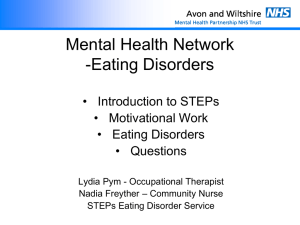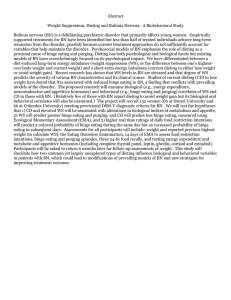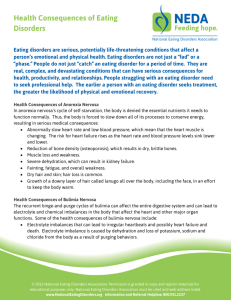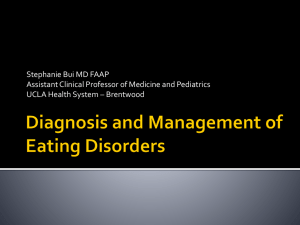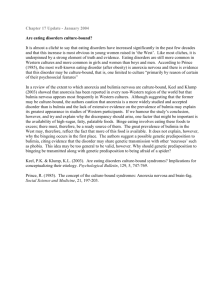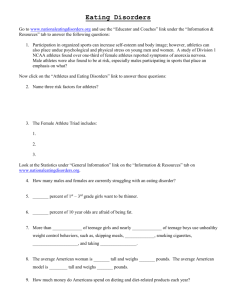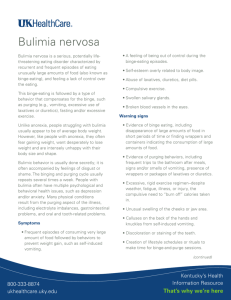Different Types of Eating Disorder Anorexia Nervosa
advertisement
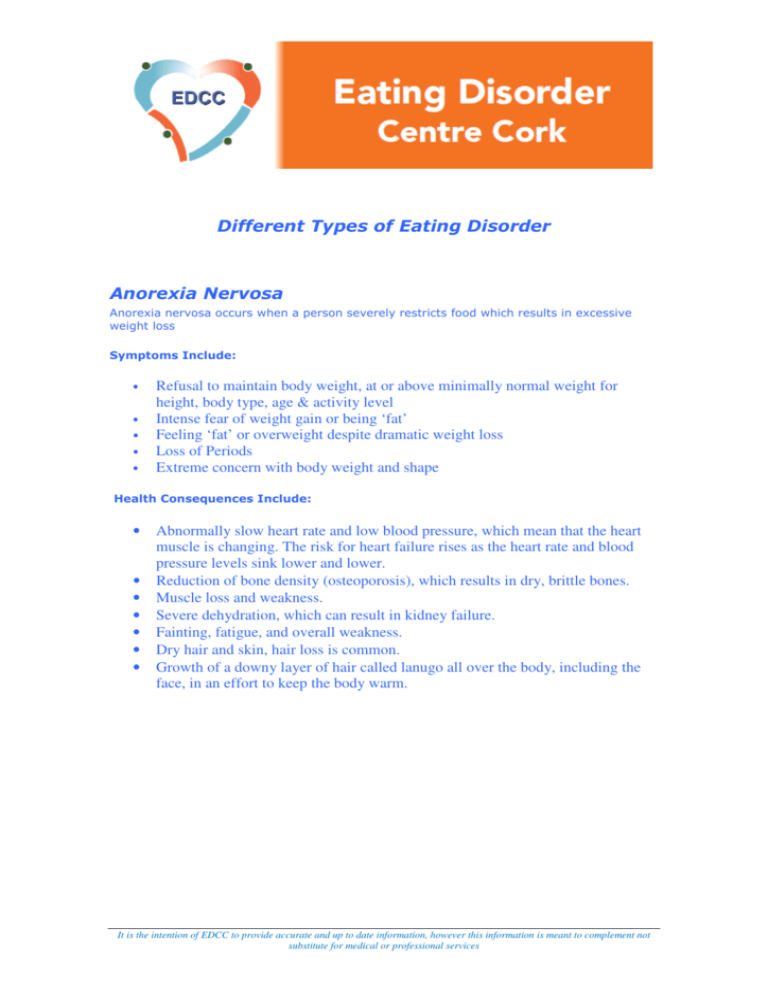
Different Types of Eating Disorder Anorexia Nervosa Anorexia nervosa occurs when a person severely restricts food which results in excessive weight loss Symptoms Include: • • • • • Refusal to maintain body weight, at or above minimally normal weight for height, body type, age & activity level Intense fear of weight gain or being ‘fat’ Feeling ‘fat’ or overweight despite dramatic weight loss Loss of Periods Extreme concern with body weight and shape Health Consequences Include: • • • • • • • Abnormally slow heart rate and low blood pressure, which mean that the heart muscle is changing. The risk for heart failure rises as the heart rate and blood pressure levels sink lower and lower. Reduction of bone density (osteoporosis), which results in dry, brittle bones. Muscle loss and weakness. Severe dehydration, which can result in kidney failure. Fainting, fatigue, and overall weakness. Dry hair and skin, hair loss is common. Growth of a downy layer of hair called lanugo all over the body, including the face, in an effort to keep the body warm. It is the intention of EDCC to provide accurate and up to date information, however this information is meant to complement not substitute for medical or professional services Bulimia Nervosa: Bulimia nervosa occurs when a person engages in a cycle of (often secretive) binge-eating followed by vomiting, excessive exercise, laxative abuse etc. Symptoms Include: • • • • • Repeated episodes of binging and purging Feeling out of control Purging after a binge Frequent Dieting Extreme concern with body weight and shape Health Consequences of Bulimia Nervosa: The recurrent binge-and-purge cycles of bulimia can affect the entire digestive system and can lead to electrolyte and chemical imbalances in the body that affect the heart and other major organ functions. Some of the health consequences of bulimia nervosa include: • • • • • Electrolyte imbalances that can lead to irregular heartbeats and possibly heart failure and death. Electrolyte imbalance is caused by dehydration and loss of potassium and sodium from the body as a result of purging behaviours. Potential for gastric rupture during periods of bingeing. Inflammation and possible rupture of the oesophagus from frequent vomiting. Tooth decay and staining from stomach acids released during frequent vomiting. Chronic irregular bowel movements and constipation as a result of laxative abuse. Peptic ulcers and pancreatitis. It is the intention of EDCC to provide accurate and up to date information, however this information is meant to complement not substitute for medical or professional services Binge Eating Disorder: Binge eating disorder occurs when a person has uncontrolled, impulsive, periods of continuous eating beyond the point of being comfortably full. There is no purging, but there may be fasting, or repetitive diets, and often feeling of shame and self-hatred after a binge. People with binge eating disorder may struggle with depression, loneliness, and/or anxiety. Their body weight may vary from normal to mild, moderate, or severe obesity. Health Consequences of Binge Eating Disorder: Binge eating disorder often results in many of the same health risks associated with clinical obesity. Some of the potential health consequences of binge eating disorder include: • • • • • High blood pressure. High cholesterol levels. Heart disease as a result of elevated triglyceride levels. Secondary diabetes. Gallbladder disease. Other Eating Disorders: Can include some of the signs and symptoms of anorexia, bulimia, and/or binge eating disorder. Whilst these behaviours may not be clinically considered a full syndrome eating disorder, they can still be physically dangerous and emotionally draining. Some of these conditions include: • • • • • Chewing and spitting food Night Eating Syndrome Selective Eating Disorder Orthorexia (obsession with pure food) Bigorexia (reverse anorexia) a form of muscular dysmorphia usually affecting men) It is the intention of EDCC to provide accurate and up to date information, however this information is meant to complement not substitute for medical or professional services



